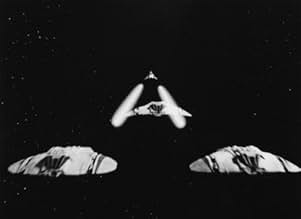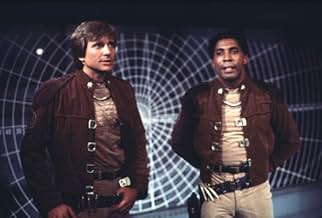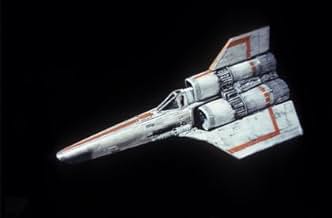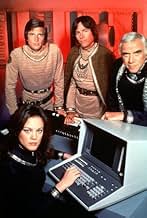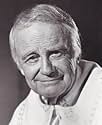Après la destruction des Douze Colonies de l'humanité, le dernier grand vaisseau de combat prend la tête d'une flotte de fugitifs et les mène à la recherche désespérée de la légendaire planè... Tout lireAprès la destruction des Douze Colonies de l'humanité, le dernier grand vaisseau de combat prend la tête d'une flotte de fugitifs et les mène à la recherche désespérée de la légendaire planète Terre.Après la destruction des Douze Colonies de l'humanité, le dernier grand vaisseau de combat prend la tête d'une flotte de fugitifs et les mène à la recherche désespérée de la légendaire planète Terre.
- Réalisation
- Scénario
- Casting principal
- Récompenses
- 1 nomination au total
Avis à la une
That would have been a novel idea for a theatrical movie, and for a TV show it was outer limits. The special effects were (by 1978 standards) top notch, the set design was good, and they even tried to create a different system of measures, since I think even in Star Trek they refer to things by minutes, hours, and years.
What let the movie (and later series) down was the same limits that affected most of seventies television. Schlocky dialogue, storylines sticking on personal and relationship problems, and somebody had the bright idea to put in a kid and a robot dog to go with him. If the series had been made today, or had simply been let free to explore ideas rather than stick to the "conventions" expected of series television, it might have been great. Instead, it's hardly remembered today.
Apparently axed by ABC because it was, at the time, very expensive to produce, there certainly was some potential in the character-building and world-building done here. Clearly, this series was borne out of inspiration from "Star Wars", but it's reasonably interesting and pretty entertaining on its own terms. It benefits from a highly engaging cast: Richard Hatch as Apollo, Dirk Benedict as Starbuck, Herbert Jefferson Jr. as Boomer, Maren Jensen as Athena, Tony Swartz as Jolly, Noah Hathaway as Boxey, and Terry Carter as Colonel Tigh, with a variety of familiar faces in guest star roles. Of these performers, Ray Milland was a particular favourite for this viewer because he's clearly having some fun playing a slimy opportunist.
Decent production values and action sequences help to keep "Battlestar Galactica" quite watchable, as well as a fair amount of humour (Starbuck likes to gamble, and develops an interest in an otherworldly musical act). It does get mildly precious when it creates a robotic "daggit" (or dog) on which Boxey can dote, but at least this particular character doesn't get *that* much screen time.
The Cylons are pretty cool villains, icy and remote and answering to an insidious being called The Imperious Leader (voiced by an uncredited Patrick Macnee). They do provide the right amount of menace. Producer John Dykstra continued here to utilize the same sort of special effects technology that he pioneered on "Star Wars"; the effects are variable, but effective overall.
The theme music by Stu Phillips is rousing enough to ensure a good time, and the story is, overall, enjoyable enough for this viewer to want to give the series a look.
As everybody knows, this was followed by an updated TV series (and TV movies) in the early 21st century.
Seven out of 10.
I would recommend any sci-fi fan to watch Battlestar Galactica.
Although this 1978 version of the film moves a little slowly in places, there are the fascinating space battles. The dialog between the characters and some of the comedy is a little dated, however. I would recommend it if you're a fan of this genre.
Viewing 'Battlestar' from the viewpoint of a near 30 male in the year 2000, I give it 7/10. (I have all 24 episodes on tape)
The special effects were near the late 70's level of "Star Wars", and that is truly saying something considering this was a made for TV movie / weekly series. Sure, the stories were uneven. However, to put that in perspective, they rode the gambit from the morality plays of Star Trek (TOS) to the character stories of Star Trek (TNG).
The backstory involved the last known group of 'humans'. After they were given a 'Pearl Harbor' job by the alien bad guys and nearly wiped out, they went in search of a long lost colony. This colony was located on a planet called 'Earth'.
This was really a revolutionary show. It took the best 'good vs evil' elements of Star Wars and combined them with the 'every show is a lesson' elements of Star Trek (TOS). If you weren't contemplating the human nature element of the story, you were involved in the characters.
Unfortunately, you were rarely concerned about both of those within the same episode. In my opinion, this is the only major flaw of the series, it was somewhat unbalanced from show to show. This is somewhat understandable from a series that was wrought with network politics and never made it past 25 episodes. Nevertheless, this is a series that would be very much enjoyed by any true sci-fi fan.
If you don't know the history of the show by now... ABC canned it, despite well above average ratings. The brass felt the show was too expensive. What could have been one of the great sci-fi TV series of all time was done after 24 episodes.
I place 'Battlestar' behind only Star Trek (TOS) as the best sci-fi TV series of all time.
Le saviez-vous
- AnecdotesAs part of a pre-release agreement with George Lucas, they were not allowed to show laser beams when they use their blasters. All you see is the weapon lighting and then whatever damage was caused. The only time you see a laser or light trail is when they are in space, the Colonial Vipers and Cylon Raiders.
- GaffesRight before Zac shoots down his first Cylon, they show his joystick. Instead of the normal "Fire/Turbo/IM" labels, it says "Stores/Camera Audio/Camera Pulse".
- Citations
Cylon Centurion: By your command.
Imperious Leader: Speak, Centurion.
Cylon Centurion: All base ships are now in range to attack the Colonies.
Imperious Leader: The final annihilation of the lifeform known as Man. Let the attack begin.
- Versions alternativesThere are Three versions of this film: a 2-hour stand-alone movie, a 3-hour pilot episode of a series (cut into 3 episodes for syndication), and a 2-hour telefilm. In the stand-alone movie version, Count Baltar is executed halfway through. This version was actually released theatrically first in Canada some months before the TV version aired in the United States. It was eventually released to theatres worldwide (including the United States). When it became apparent that the series would in fact be made, Baltar's execution scene was re-edited and an extra scene with him was filmed for the end which sets up the series. In the series version, Count Baltar is held for public execution instead of being beheaded immediately. When the Cylon Imperious Leader who ordered his execution is killed in the explosion of the planet Carillon, his successor orders Baltar's release so Baltar can take command of a Cylon Basestar that will chase the human refugees throughout the series. All this information is given in an "Epilogue" tacked on at the ending. The telefilm version of the film consists of a cut down version of the series 3-hour premiere episode with added scene. There was a total of 12 telefilms made from the series. These 12 telefilms were shown in local markets most of which was in the afternoon rotated with Godzilla, Gamera, and other films.
- ConnexionsEdited from Galactica (1978)
Meilleurs choix
- How long is Battlestar Galactica?Alimenté par Alexa
Détails
- Date de sortie
- Pays d’origine
- Site officiel
- Langue
- Aussi connu sous le nom de
- Galáctica: astronave de combate
- Lieux de tournage
- Sociétés de production
- Voir plus de crédits d'entreprise sur IMDbPro
Box-office
- Budget
- 3 000 000 $US (estimé)
- Durée
- 2h 28min(148 min)
- Mixage
- Rapport de forme
- 1.33 : 1



